
National
Skydiving
League
226 Pecan Street
Deland FL 32724
tel: (386) 801-0804
© 2003 - 2025
All Rights Reserved


226 Pecan Street
Deland FL 32724
tel: (386) 801-0804
© 2003 - 2025
All Rights Reserved

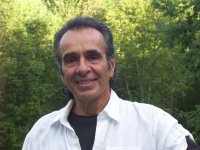
John J. DeRosalia did this translation in his book that he published in 2001. The NSL News posted the interview with him on 27 February 2002.
"Skydiving helped John J. DeRosalia to fix his own life at a certain time in his life. Now he is helping to fix the psyche of skydivers. 'Mental Training for Skydiving and Life' is a 'Mind/Body/Spirit Training Program for Achieving Peak Performance in Skydiving and Life'. His book was published ![]() in 2001, and it is available in the NSL Shop."
in 2001, and it is available in the NSL Shop."
"John J. DeRosalia has worked with the best 4-way teams in the world, like Arizona Airspeed, the Golden Knights, FX and Sebastian XL. When he worked for Skydive University and 'The Search' last week in DeLand, the NSL News invited him for an interview. He is also known as 'Dr. John' and explains his own motivation to help teams and competitors, why mental training is still not used enough in skydiving, and what his book is all about."

John J. DeRosalia: I began skydiving and fell in love with it like many people do. Then I tried to think of a way to incorporate what I love to do with making a living. A lot of people do that, fall in love with skydiving and try to make it a part of their lives. I looked around and tried incorporate peak performance training with the sport. No one was doing that.
NSL News: How did you get motivated to begin skydiving?
John J. DeRosalia: That's interesting. My life fell apart about five years ago. Everything in my life seemed to crumble to the ground. My family ended, I was supposed to be moving to New Mexico and that fell apart. So many of the things that were the ground I was standing on didn't exist. I became depressed. Through a series of remarkable coincidences I met a hang glider and skydiver the same week, the skydiver was Tina from the Ranch. I've always been terrified of heights and airplanes and I thought this would be a wonderful challenge and distraction - so I tried it.
NSL News: A skydiver fixed your life, and then you began fixing skydivers?
John J. DeRosalia: Skydiving at that time gave me something to feel passionate about, something that I loved and certainly a place to learn. I'm still afraid of heights. Could never be a base jumper. Initially I thought like most people. Skydiving was for thrill seekers, they jump for the adrenalin over and over. I learned there was more too it.
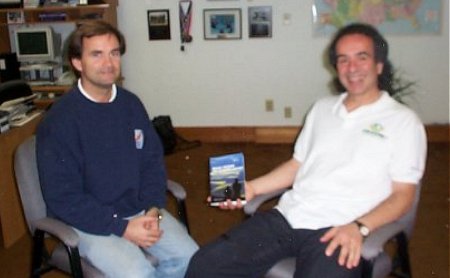
John J. DeRosalia: It happened very quickly for me. During my AFF, I passed my AFF without failing any levels but I did not feel coordinated. It was hard to have awareness in the air. Simple things like being aware of arms, legs or eye contact was hard for me. When I saw videos, I saw the amazing things top teams were doing. Where I was and where they were, it was an incredible road to get there. I was doing solo or jumping with someone at my skill level. I just realized how much there was to learn and how little in touch with my body I was. I've been connected from the neck up.
NSL News: Would you consider skydiving as athletic and as competitive as other sports?
John J. DeRosalia: I was greatly impressed with physical and mental skills that went into the training. I've worked with other sports, but not so comprehensively. In private practice I've worked with climbers, high-risk sports, musicians, writers, baseball players and world-class archers, but never in such a comprehensive way with a program.
NSL News: Did you pick it up because now you were a skydiver yourself?
John J. DeRosalia: Yes, I was enthusiastic, but not in a professional way. My goal has never been to be a world-class skydiver. Personally I don't think I'm a good skydiver - I'm a fun skydiver. I have 760 jumps and there are those with 250 jumps that are better. My fascination is not with the technical skills, it's with the subtleties of the sport.
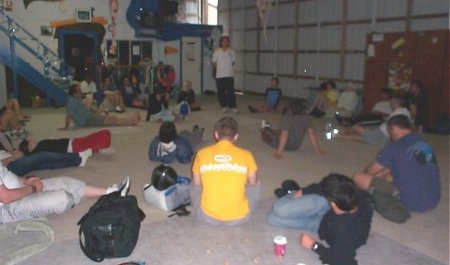
John J. DeRosalia: Yes, first I've ever written.
NSL News: Are we going to see second edition?
John J. DeRosalia: You're certainly going to see more of my writing, either in articles or a second edition. I'm not done with skydiving, there's still a lot I want to learn and do.
NSL News: How much professional work do you do with skydivers?
John J. DeRosalia: About 25 percent.
NSL News: Which teams are you working with?
John J. DeRosalia: I've worked with Generation FX, Golden Knights and the U.S. Parachute Team. Currently I'm working with Skydive University and Sebastian XL.
NSL News: You say in your book that although skydiving competition requires such good mental skills, you are surprised that the mental training in skydiving has not been explored and mental training is not being used more than it is.

NSL News: What are the main ingredients of that structure?
![]() John J. DeRosalia: Skydivers visualize, but we do more. Skydiving is a visual kinesthetic sport. It uses the sense of vision and touch. Often you will see skydivers combine the two, sometimes by taking grips, sometimes by moving their body. Dirtdiving is visual kinesthesia. We can maximize the visualizations, we can get more out of it. I don't know that most skydivers appreciate the incredible learning effect from the visualizations once your centered.
John J. DeRosalia: Skydivers visualize, but we do more. Skydiving is a visual kinesthetic sport. It uses the sense of vision and touch. Often you will see skydivers combine the two, sometimes by taking grips, sometimes by moving their body. Dirtdiving is visual kinesthesia. We can maximize the visualizations, we can get more out of it. I don't know that most skydivers appreciate the incredible learning effect from the visualizations once your centered.
NSL News: Explain centered for me, please.
John J. DeRosalia: Centered is when your thinking is focused in one area. There may be distractions, but you don't pay attention.
NSL News: Centering comes first, before visualization?
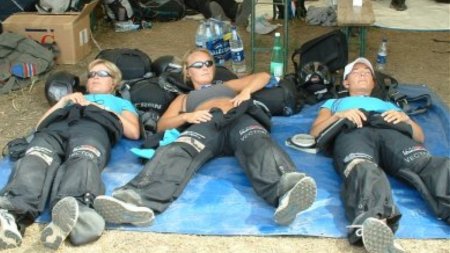
NSL News: What other areas of mental training could skydivers profit from?
John J. DeRosalia: We all have faulty or limiting belief systems, patterns, habits and ways of thinking that get in our way.
NSL News: That is where you begin reframing?
John J. DeRosalia: That would be one place to begin reframing. Reframing is looking at a situation and simply turning it around so it can benefit you - the skill of being able to find value in any circumstance or situation.
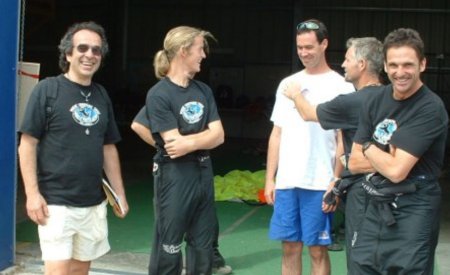
John J. DeRosalia: What I begin doing with teams is to help put them in alignment. When you have a team, say 4-way, you have a group of individual skydivers, each with their own style, each with their own ego, all pursuing the same goal. Very often in any team there are subtleties, sometimes major differences on how to achieve the goal. A team's communication in the air is directly related to their communication on the ground. Often teams think they are in total communication and they are not. The book actually covers how an individual improves his own mental skills and it covers also how a team improves. The key to mental training, whether as an individual or as a team, is to have, as the expression says, all of the ducks in a row. What a general needs to do is to have all his troops focusing the correct way. If they are scattered, the extent of how scattered or out of alignment they are is the extent to how weak they are. When I work with individuals, I help that individual to see that mentally, physically, emotionally and spiritually they are pointed in the direction of their goal. If someone has a higher, loftier goal and has habits or ways of thinking that may get in the way, those things will impact ![]() their ability to reach that goal.
their ability to reach that goal.
NSL News: Compared to people in other areas that you are working with, is it more difficult to line up and straighten out skydivers?
John J. DeRosalia: Sometimes, but not necessarily. Skydivers often have very large egos, but not all do. So I don't know that I would say they are any different from people who are in the top in their field. Sometimes it is true and sometimes I find world-class athletes that are eager to learn.
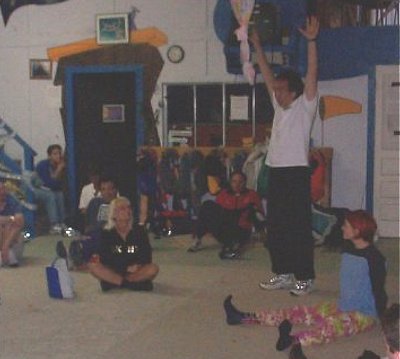
John J. DeRosalia: I've come not to use the word normal anymore, even before I entered skydiving. I don't know that there is a normal anymore. We are certainly an interesting and sometimes unusual bunch. The one thing I would like to say about my working in skydiving is that - in my opinion - at least 95 percent is mental challenge, the other 5 percent physical, especially at the world-class level. When you think of track and field, sometimes the difference between medals is 1/100 or 1/10 of a second. The other great challenge as a skydiver is that they don't have warm up time, they sit in the plane and then they are on instantly - no inning or quarter to warm up. In terms of mental challenge, they have to be able to focus, and focus instantly after some time of inactivity.
NSL News: Can skydiving teams afford you?
John J. DeRosalia:  Skydiving teams can afford me - most don't want to spend that kind of money though. So generally the only ones that have worked with me are the ones at the top. I guess another way to answer, teams that hire me are teams that are committed to experimenting with another method to make their skydiving work. Working with a peak performance coach is an experiment.
Skydiving teams can afford me - most don't want to spend that kind of money though. So generally the only ones that have worked with me are the ones at the top. I guess another way to answer, teams that hire me are teams that are committed to experimenting with another method to make their skydiving work. Working with a peak performance coach is an experiment.
NSL News: The book title is "Mental Training for Skydiving and Life". We have covered the skydiving, how does it transfer to life?
John J. DeRosalia: I think that skydiving and life are interchangeable. Skydiving is a metaphor for life, which is regardless of the client, regardless of the sport, regardless of the area that they are interested in achieving peak performance. There are very basic principles that we need to work on – our belief systems, our self-esteem, our drive and our motivation. These are all very basic life skills.
NSL News: Thank you, Dr. John.